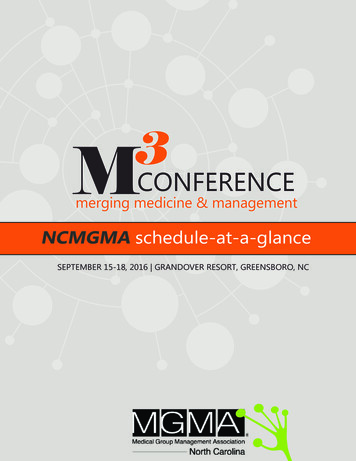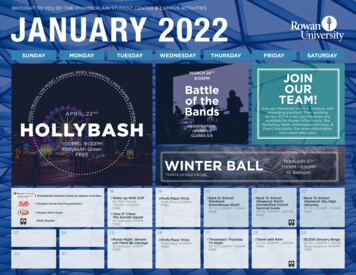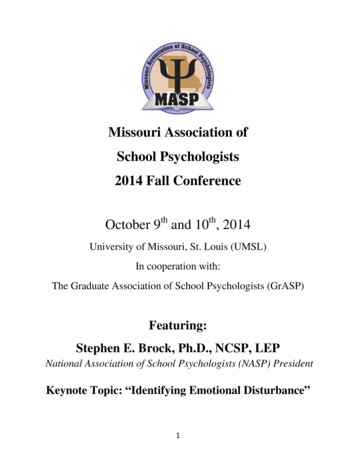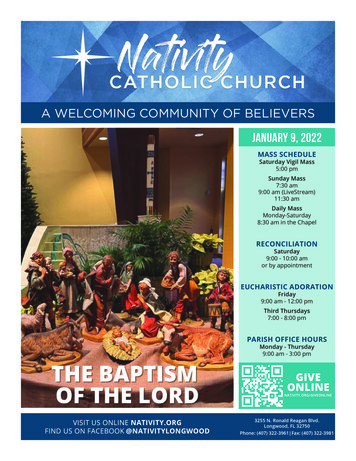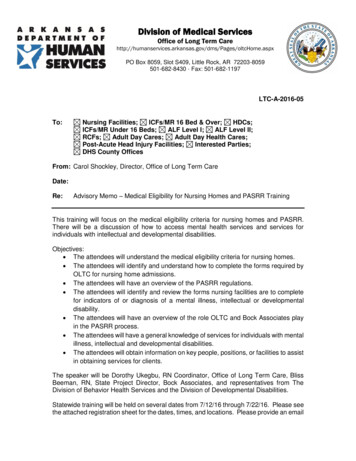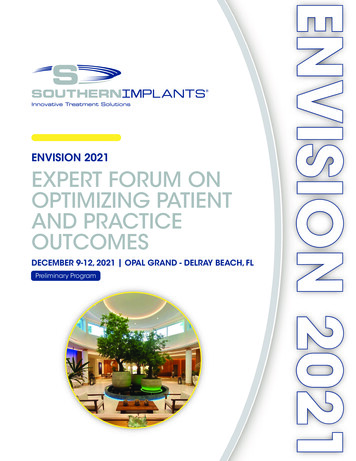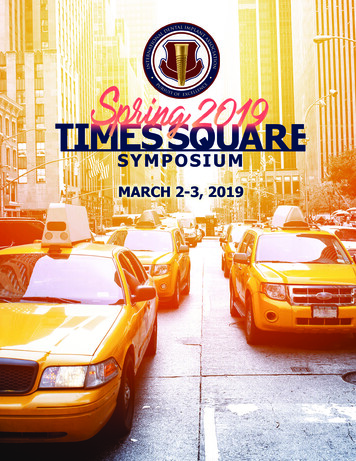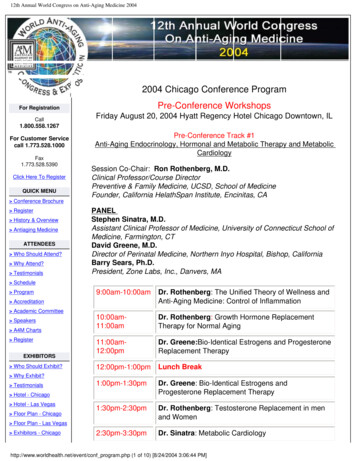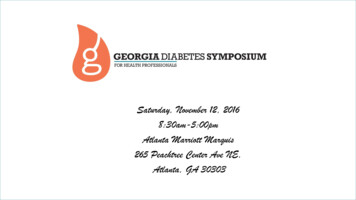
Transcription
Saturday, November12, 2016 12, 00pmMarriott Marquis265Peachtree MarriottCenter Ave NE,AtlantaMarquisAtlanta, GA 30303265 Peachtree Center Ave NE,Atlanta, GA 30303Division of Diabetes Translation
Disclosures to ParticipantsRequirements for Successful Completion:For successful completion, participants are required to be in attendance in the full activity, complete andsubmit the program evaluation at the conclusion of the educational event.Conflicts Of Interest and Financial Relationships DisclosuresPlanners:LaShonda Hulbert, MPH - NoneLisa Graham, RN, BSN, CDE – NoneSarah Piper, MPH, CDE – NoneCaSonya Green, MA, CHES, CDE – NoneGerald Griffin, RPh – NoneJessica Knopf, MSW – NoneGlenda Summerville, DNP, BC-ADM, CDE, FNP-C – NonePresenters:Sarah Piper, MPH, CDE – NoneSaturday,DNP,November12,CDE,2016FNP-C – NoneGlenda Summerville,BC-ADM,Darin Olson, MD, PhD– None8:30am-5:00pmMonica W. Parker, MD – NoneAtlantaWhitney Wharton,PhDMarriott– None MarquisMichael Crooks,PharmD – CenterNone Ave NE,265 PeachtreeYiling J Cheng, MD, PhD – None30303Betsy Rodriguez,Atlanta,MSN, DE GA– NoneFritz Jean-Pierre, MD, FACS, FASMBS – Speakers Bureau – Ofirmev, PaciraPatricia Tatro, LCSW, MSW, MSM – NoneMichelle Bravo, RD, CDE – Employee, Stock – DexcomFadi Nahab, MD - NoneDivision of Diabetes Translation
Disclosures to ParticipantsDisclosure of Relevant Financial Relationships and Mechanism to Identify and Resolve Conflicts ofInterest: Undertaking review of the educational activity by a content reviewer to evaluate for potentialbias, balance in presentation, evidence-based content or other indicators of integrity, and absence ofbias, AND monitoring the educational activity to evaluate for commercial bias in the presentation ANDreviewing participant feedback to evaluate for commercial bias in the activity.Sponsorship / Commercial Support: Novo Nordisk, Inc., Southeastern Primary Care Consortium, Inc.Atlanta Area Health Education Center (SPCC Atlanta AHEC),Non-Endorsement Of Products:Approval status does Saturday,not imply endorsementby AADE, ANCC, ACPE or CDR of anyNovember 12, 2016commercial products displayed in conjunction with this educational activity.8:30am-5:00pmOff-Label Use:Atlanta Marriott MarquisParticipants will be notified by speakers to any product used for a purpose other than thatPeachtreeCenterAve NE,for which it was approved by the265Foodand DrugAdministration.Atlanta, GA 30303Activity-Type : Knowledge-basedDivision of Diabetes Translation
This continuing nursing education activity was approved by The AmericanAssociation of Diabetes Educators, an accredited approver by the AmericanNurses Credentialing Center’s Commission on Accreditation. This program2016-054 is awarded 6.0 contact hours of continuing education credit.The AADE is also accredited by the California Board of Registered Nursing(CEP#10977).The American Association of Diabetes Educators is accredited bythe Accreditation Council for Pharmacy Education as a provider ofcontinuing pharmacy education. This program provides 6.0 contacthours (.60 CEU’s) of continuing education credit.ACPE 12,0069-0000-16-255-L01-P;201616-256-L01-P; 0069-0000-16-257-L01-P; 0069-0000-16-258-L01-P; 00690000-16-259-L01-P; 8:30am-5:00pm0069-0000-16-260-L01-P; 0069-0000-16-261-L01-P;Atlanta -264-L01-P;0069-0000-16-265L01-P265 Peachtree Center Ave NE,Effective Date: November 12, 2016 to November 12, 2017Atlanta, GA 30303Sponsored by The Diabetes Association of Atlanta, a designated provider ofcontinuing education contact hours (CECH) in health education by the NationalCommission for Health Education Credentialing, Inc. This program is designatedfor Certified Health Education Specialists (CHES) and/or Master Certified HealthEducation(MCHES) to receive up to 6 total Category I continueDivisionSpecialistsof Diabetes Translationeducation contact hours.
Yiling J Cheng, MD, PhDGiuseppina Imperatore, MD, PhDEdward W Gregg, PhD2016 Georgia Diabetes Symposium for Health professionalsTime: November 12, 2016Presenter: Yiling Cheng, ycheng@cdc.govDivision of Diabetes Translation
Presenter DisclosureYiling ChengDisclosed no conflict of interestThe findings and conclusions in this report are those of the authors and donot necessarily represent the official position of the Centers for DiseaseControl and Prevention.
Objectives Describe the burden of hearing impairment among personswith diabetes Describe the association of diabetes and hearing impairment Demonstrate the trends in hearing impairment among personwith and without diabetes
This presentation is going to Provide a general overview of the nature of hearing, hearingimpairment (HI), and diabetes & diabetes complication Show the burden of HI Discuss the risk factors of HI, especially on the association ofdiabetes and HI Show the trend in HI among persons with and withoutdiabetes
Diabetes - Timeline 0050 Aretaeu, the Greek physician, coined the terms diabetes mellitus (to pass through,honey-sweet, urine disease), diabetes insipidus (to pass through, dilute and odorless) Symptoms of marked hyperglycemia include polyuria, polydipsia, weight loss, sometimeswith polyphagia, and blurred vision 1955 the oral glucose tolerance test (OGTT) was widely adopted as a diagnostic method 1979 the diagnostic criteria for diabetes were recommended by the National Diabetes DataGroup and WHO (1985): fasting plasma glucose (FPG) 140 mg/dl (7.8 mmol/l) or 75-gram2-h OGTT 200 mg/dl (11.1 mmol/l ) 1997 (ADA) and 1999 (WHO) the ADA changed criteria of FPG into 126 mg/dl ( 7.0mmol/l) 2009 the ADA chose A1C 6.5% (47.5 mmol/mol) as a cut point for diagnosis of diabetes
Trends in Incidence and Prevalence of Diagnosed DiabetesAmong Adults Aged 20-79, United States, 1980-2014National Diabetes Surveillance System, 2016.
Diabetes and chronic complications Cardiovascular damage (macro- and micro-)Nerve damage (neuropathy)Kidney damage (nephropathy)Eye damage (retinopathy)Skin damage (infections, ulcer)Foot damage (infections, amputation)Hearing Impairment
Importance of hearing impairment (HI) HI is the 3rd most prevalent chronic condition in olderAmericans, after hypertension and arthritis (Yueh, 2003) Approximately 1 out of every 3 people aged 65 years or olderare affected by disabling hearing loss (WHO, 2015) 20.3% or 48.1 million Americans aged 12 or older suffering HI Persons with diabetes had higher risk of HI than personswithout diabetes
Consequences of hearing impairment irritability, negativism and angerfatigue, tension, stress and depressionavoidance or withdrawal from social situationssocial rejection and lonelinessreduced alertness and increased risk to personal safetyimpaired memory and ability to learn new tasksreduced job performance and earning powerdiminished psychological and overall health(Better Hearing Institute, 2016)
Adjusted risk ratio of death (HI vs. non-HI)Compared with normal hearing,HR: 1.20 (1.03, 1.41),after adjusting for demographicand CVD risk factorsGenther (2015)
Recommended to assess of these additional common comorbid conditions (B):Diabetes Care, supplement 1
Measure of Sound Frequency (octave) “low” or “high”, hertz (Hz) used as a unit Normal hearable frequency range: 2o Hz to 20 kHz Intensity “soft”/ “ quite” or “loud”, decibel (dB) used as a unit Normal lowest hearable level: the sound pressure of 0.0002μbar (dyne/cm2), which is 0 dB, dB 20 log(μbar / 0.0002)
Decibel levels of common sound source Rustling leaves:Quiet whisper (1 m):Home room at night:Whispered speech:Normal conversation (1 m):Car noise:Buses:Diesel truck:Ambulance siren:Jet taking off at 200 feet:20 dB30 dB40 dB50 dB60 dB70 dB80 dB100 dB120 dB140 dB
Auditory/hearing system
Types of hearing impairment/hearing loss Conductive HI Sensorineural HI Mixed Hearing HIThese types of HI can be bilateral or unilateralSuzuki 2004
Tools of measuring hearing function Questionnaire (HHIE-S) (Lichtenstein, 1988)Whispered voice testVibrating tuning fork or finger’s rubbingAudioscope Audiometer, the pure tone audiometry is the gold standard forassessment of a hearing loss
Classification of hearing impairment WHO Hearing thresholds and grades 25 dBnormal 26 - 40 dBslight/mild 41 - 60 dBmoderate 61 - 80 dBsevere 81 dBprofound Disabling hearing loss refers to hearing loss greater than 40 dB inthe better hearing ear in adults and a hearing loss greater than 30dB in the better hearing ear in children Usually, using a pure-tone average (PTA), for example, an averageof hearing thresholds at 0.5, 1, 2, and 4 kHz
NHANES, aged 70 Bainbridge (2014)
70 Low or mid frequencySpeech frequencyHigh frequencyLin (2011)
Prevalence of hearing impairment by sex and age group- NHANES 1999-2010 (PTA 25 dB) and NHIS 2007 (self-reported)Bainbridge (2014)
Lin (2011)
Risk factors of hearing impairment Aging Loud noise (Occupational noises, recreational noises. Persons areexposed to noise intensity 85 dB required hearing protection bythe NIOSH) Heredity Ototoxic medication, such as gentamicin, chemotherapy drug,high doses of aspirin, pain relieves, etc. Illness, such as meningitis, high fever, infections during pregnancy Cardiovascular risk factors, such as smoking, obesity, diabetes,dyslipidemia etc.
Smoking & HIHearing loss was defined as a PTA (0.5, 1, 2, 4 kHz) 25 dB Hearing level in the worse earCruickshanks (1998) Beaver Dam Eye Study, Wis.
Obesity & HI24.9%20.4%21.8%23.2%24.1%Kim (2016)
Soft/QuietLoudLow pitchHigh pitchAgrawal (2009)
Agrawal (2009)
Average decibels hearing level of the U.S. adults, NHANES 1999-2004Aged 20 to 69 yearsAged 20 to 29 yearsBainbridge (2008)
Average decibels hearing level of the U.S. adults, NHANES 1999-2004Aged 30 to 39 yearsAged 40 to 49 yearsBainbridge (2008)
Average decibels hearing level of the U.S. adults, NHANES 1999-2004Aged 50 to 59 yearsAged 60 to 69 yearsBainbridge (2008)
Age adjusted the prevalence ofself-reported HI:with diabetes:38.9%without diabetes: 21.7%PR: 38.9/21.7 1.8Bainbridge (2008)
Horikawa (2013)
Bainbridge, Cheng (2008)
Bainbridge (2014)
NHANES adults aged 25-69 yrs1971 - 19731999 - 2004Cheng (2009)
NHANES, aged 70 Bainbridge (2014)
NHANES, aged 70 Bainbridge (2014)
NHANES, aged 70 Bainbridge (2014)
ycheng@cdc.gov
The AADE is also accredited by the California Board of Registered Nursing (CEP#10977). The American Association of Diabetes Educators is accredited by the Accreditation Council for Pharmacy Education as a provider of continuing pharmacy education. This program provides 6.0 contact hours (.60 CEU's)of continuing education credit.
